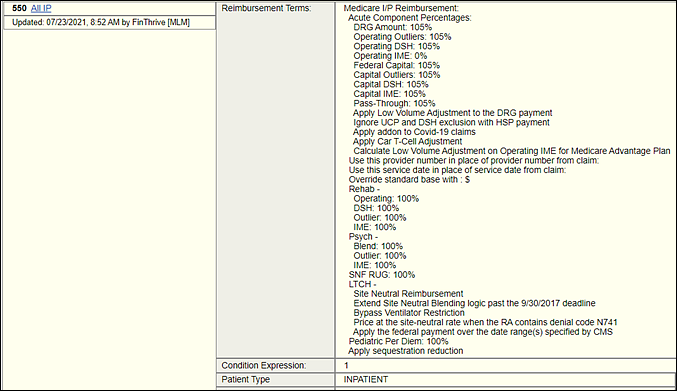The TRICARE reimbursement tool calculates TRICARE reimbursement amounts. Effective November 1, 2008, All outpatient hospital services calculate based on APC reimbursement except for the following, which reimburse based on fee schedules:
- Lab
- Therapies
- Mammography
- Pneumonia
- Injections
- Ambulance
- Any applicable state or regional fee schedules
The TRICARE reimbursement tool includes tabs that allow you to define separate reimbursement terms for IP, OP, and ChampVA OP patients.
Contract Manager provides reimbursement tools (specifically known as Government Programs nodes), for profiles utilizing Government pricing.
The facility-specific factors play a critical role in how the reimbursement tool or node reprices a claim (see Provider Profile page.) These factors are loaded into Contract Manager along with FinThrive government settings and the terms of the contract. Together they are used by the tool to calculate expected reimbursement. The Reimbursement Terms on the profile displays the contract terms.
Part of defining a service type is adding its reimbursement terms (using reimbursement tools). While the service type and its reimbursement terms are related, neither one inherits data from the other. Therefore, in order to ensure that you define terms for each service type using the appropriate reimbursement tool(s), you must set up each part individually.
A service type serves two purposes:
- Determine if the item on the claim qualifies for reimbursement.
- Once qualified, indicate how the service type processes the item on the claim.
The purpose of a reimbursement tool is to calculate the reimbursement for the associated service type.

Each reimbursement tool includes additional information called checkpoints. These items include tips, reminders, shortcuts, and other helpful information about the tool not found in the field descriptions.
Each reimbursement tool there is an associated help topic that includes a table called Field Descriptions. These descriptions address the meanings and implications of fields and options that appear on each reimbursement tool.
An operand is a name that references a value (dollar amount, number, date or code) on a claim. Operands are available to calculate reimbursement in the following reimbursement tools:
- Percentage
- If Test
- Formula
- Range
For more information about operands, refer to Operands.
Many of the reimbursement tools allow you to select a specific procedure lookup table. If the procedure on a claim is found in a lookup table associated with a particular reimbursement tool, that procedure is priced according to the rules of that reimbursement tool. A procedure code matches an entry in a lookup table according to the following rules:
- If the procedure code for the line item does not have a modifier, the procedure code in the lookup table must also not have a modifier for a match to occur.
- If the procedure code for the line item has the same modifier as the procedure code in the lookup table, a match occurs.
- If the procedure code has a TC (Technical) or 26 (Professional) modifier, the procedure in the lookup table must have a TC or 26 modifier for a match to occur.
- If the procedure code has a modifier other than a TC or 26 modifier, the procedure in the lookup table cannot have a TC or 26 modifier.
- If the procedure code has a modifier other than TC or 26, and the procedure code in the lookup table does not have a matching modifier, but is listed without a modifier, the code without a modifier is considered a match to the line item procedure code.
- If the procedure code for the line item is not found in the procedure lookup table, no match occurs.
The menu on the left provides detail information on the reimbursement tools available on the Service Type Reimbursement Editor page. These tools represent the different reimbursement methods available for repricing a claim.
The following topics provide detail information on the reimbursement tools available on the Service Type Reimbursement Editor page. These tools represent the different reimbursement methods available for repricing a claim.
